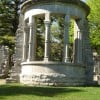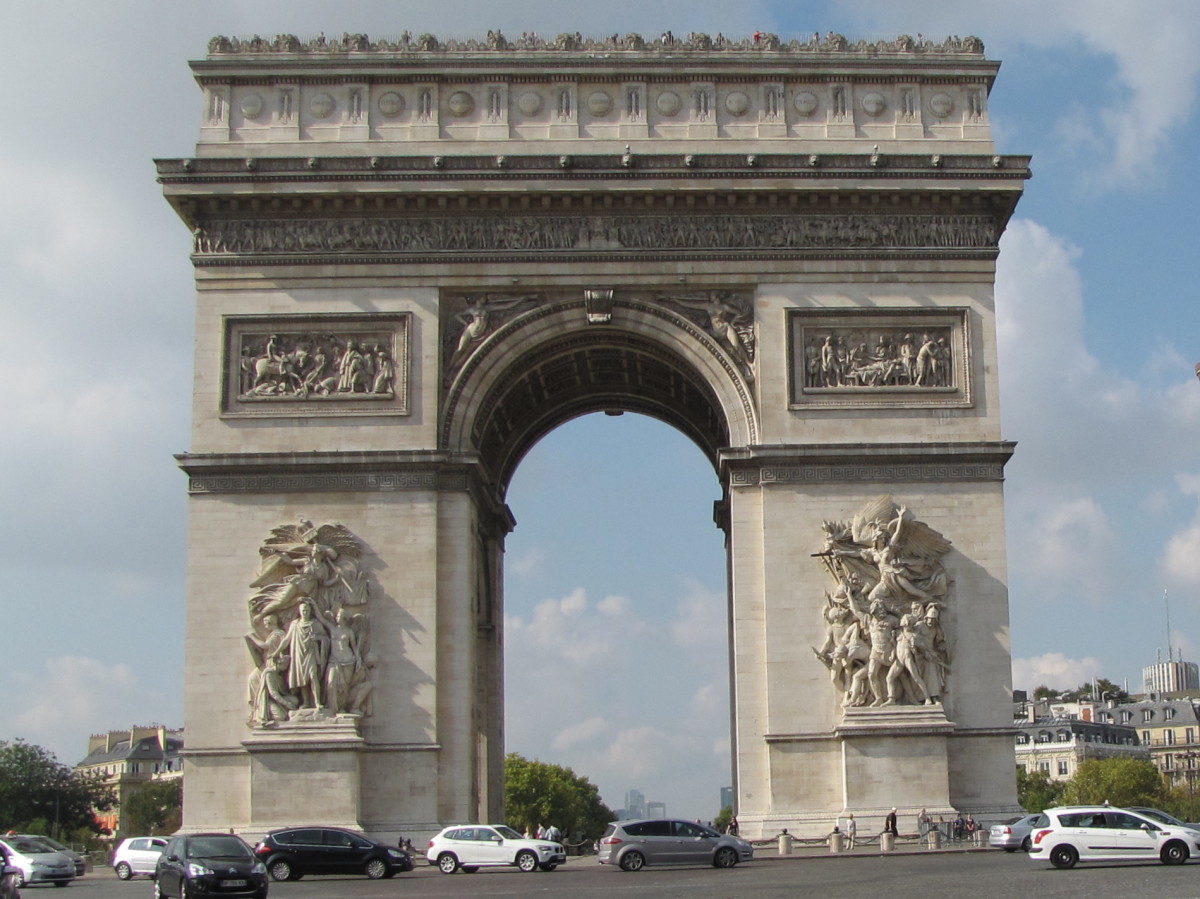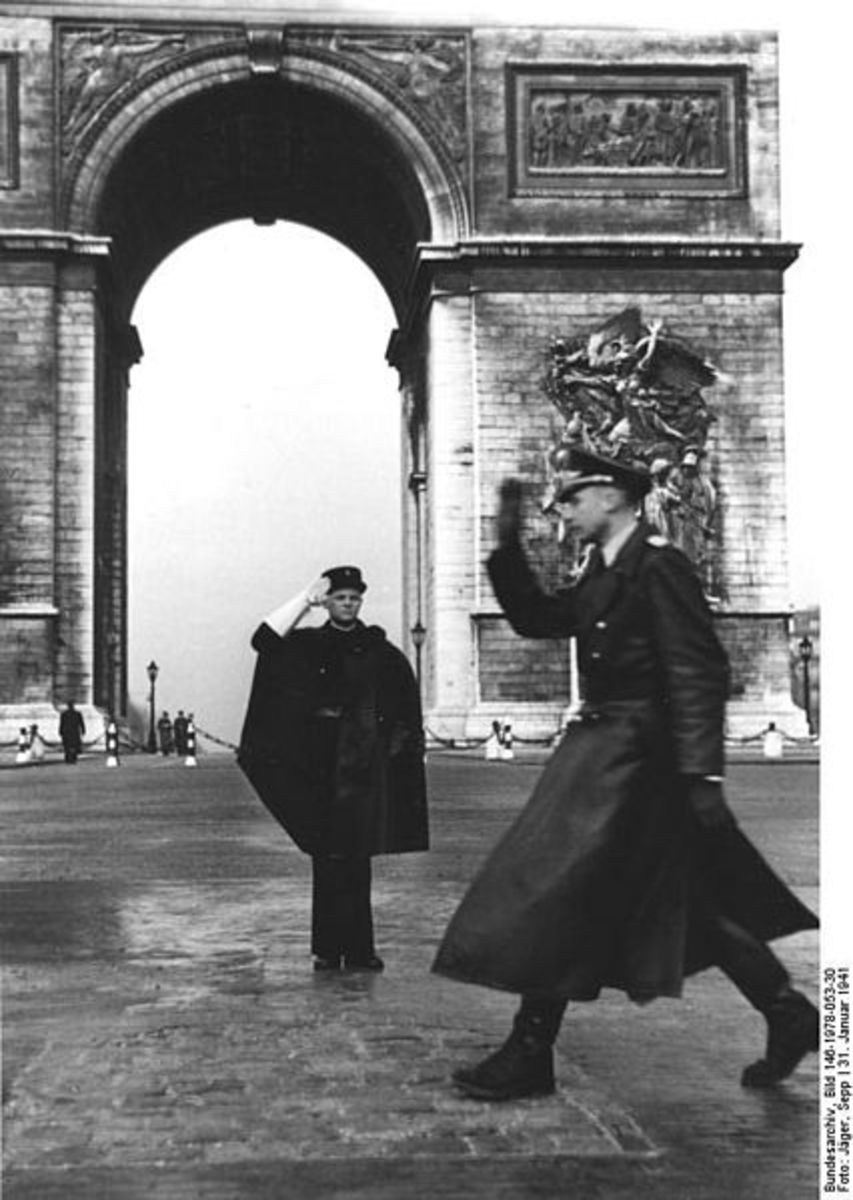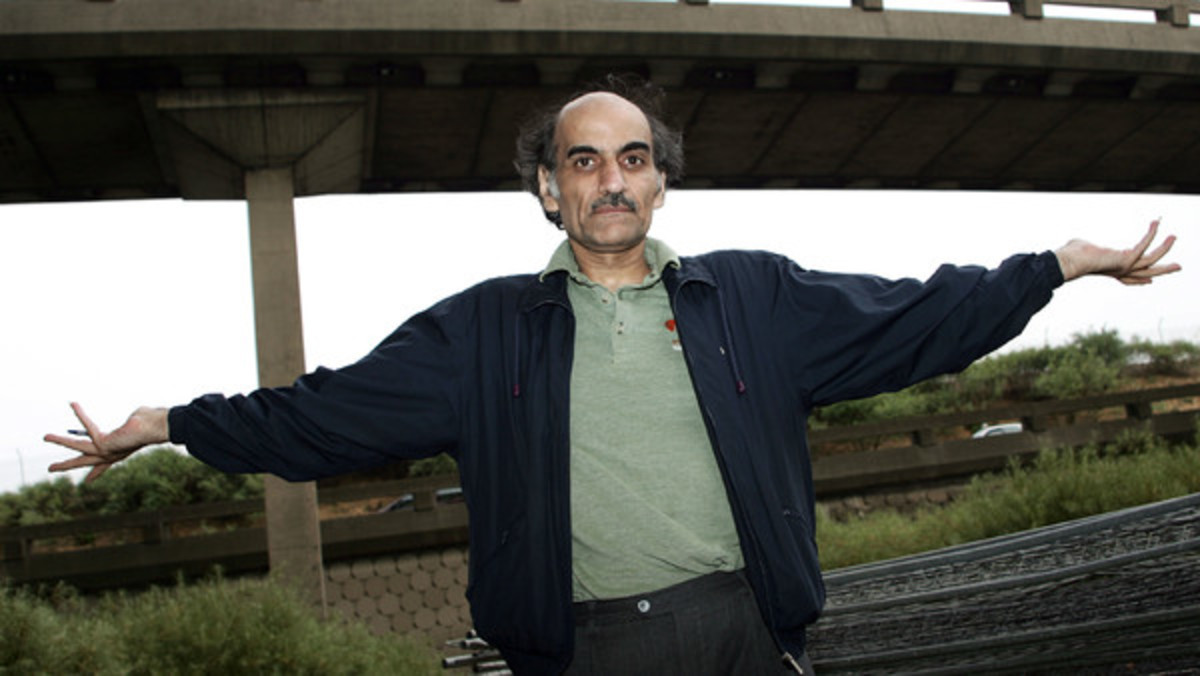Visiting Abeele, France: neo-Gothic architecture and administrative nuances
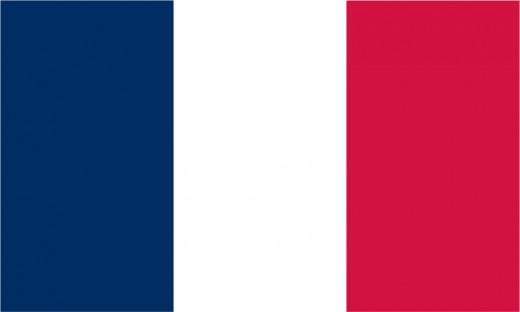
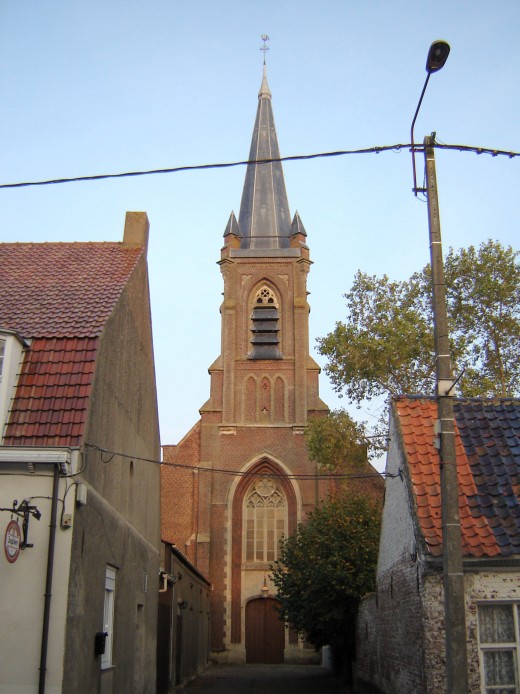
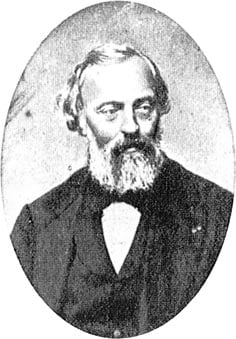
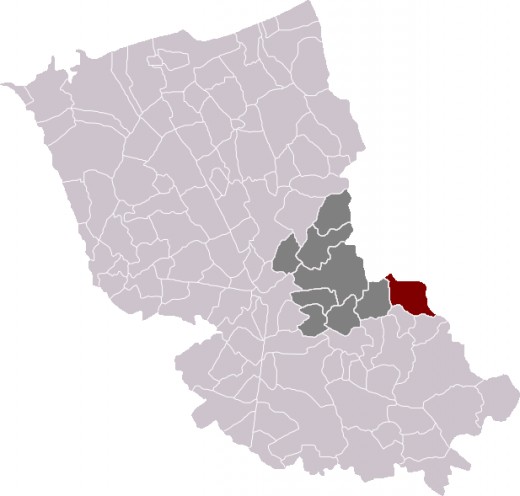
Surprises in store
Abeele, in northern France, is noted for its neo-Gothic church, the work of eminent architect Charles Leroy (1816-1879).
The church's smooth lines and pointed spire combine to present a very typical example of the style in which Leroy specialized, as did another of his near-contemporaries, Viollet-Le-Duc. Among the church architectural projects with which Leroy was associated is the Cathedral Basilica of Notre-Dame-de-la-Treille, Lille. While unfinished in Leroy's lifetime — indeed, completed only in recent years — this Cathedral Basilica is probably among the works for which Leroy is best known. The fact that Abeele's church design carried his imprint also thus gives it a certain context of distinction.
With its main frontage situated off Abeele's rue de Cassel, the church's rear backs onto open fields across which the spired church is a significant local landmark.
Separation of church and state, 1905, and aftermath
The experience of separation of church and state in France did not come easily in the region. Boeschèpe, to which municipality Abeele partly belongs, saw a violent confrontation during which a man was killed in the parish church.
In Abeele, nuns who had taught in French in a school on the French side of the rue de Cassel felt obliged to move to another part of Abeele which is in Belgium. That is, for the nuns, 'safely' in Belgium for them to continue their French medium classes there, which was — and is — mainly Dutch-speaking. The building in which this French school (in Belgium) functioned for years afterward is now a local community hall.
Issues related to church and state are even today not very clear cut, locally.
This church in Abeele, designed by Charles Leroy, is indeed in France. But its parishioners are mainly Dutch-speaking; its clergyman is Belgian; the parish belongs in ecclesiastical terms to the Belgian diocese of Bruges (Dutch: Brugge )(1).
And so in 2009 when the Socialist mayor of Boeschèpe attested that the condition of the fabric of the church building had deteriorated to the extent of being no longer safe for people to use, he closed the church. The administrative subtleties which have been in evidence in relation to this building are rather interesting. Although the church is in France, Belgians mostly use it, and the municipality of Poperinge, to which the Belgian part of Abeele (spelt 'Abele' in Belgium) belongs has in the past tacitly allowed itself to pay for the repairs. Yes, a Belgian municipality assists in financing a structure not only in another municipal — but also national — jurisdiction, where the local authorities may not necessarily be counted on to defray all the expenses themselves.
One Abeele; three administrative tunes
Another subtlety: Abeele, officially not existing as a whole in any municipal jusrisdiction, is, on the Belgian side partly in Poperinge, and partly in Watou. But then it gets more complicated, because a number of years ago the boundaries of many Belgian municipalities were fused together. In unambiguous terms, at least some of the Belgian part of Abeele (or Abele) used to belong to Watou. But after the administrative changes, Watou continued to exist, but as a subdivision of Poperinge. So today, Belgian Abeele (or Abele) is specifically divided between Poperinge proper, and the Watou division of Poperinge.
Part of the significance of this is that the authorities of local municipalities still do not recognize Abeele as officially existing as an entity. There has not even been any attempt to coordinate street name translations: where on the French side, rue de Cassel is the name, the other side, in Belgium, is called Abeleplein .
In any case, when I arrived in Abeele and crossed the international boundary, no one took any notice of me, and certainly not at the café, which seemed to double as a customs post.
The British part of Abeele
The British.
Yes. Part of the land at Abeele is British to perpetuity. And most deservedly so, because just outside the built up area, near the French border but just into Belgium is Abeele Aerodrome Military Cemetery. Some of the slaughter of World War 1 took place in and around Abeele, when foreign armies decimated each other's lines over a few square metres of territory. (Hardly 20 years later, they started all again, but this is another story.) After World War 1, Belgium's King Albert I decreed that Abeele Aerodrome Military Cemetery should always remain British territory.
British, Belgian and French attempts at spelling
Except that, although the British cemetery is on the Belgian side of the border, the British spell their cemetery 'Abeele': yes, the French way.
But then it transpires that the French way is also the way Belgians used to spell the name of the village. Before the Edict, that is.
It is all to do with the edicts of the council of what is known as Algemeen Beschaafd Nederlands (i.e., General Refined Dutch, or, how refined people ought to write) and how it thinks vowels before a consonant, and, more particularly, the vowels in 'Abeele', ought to be written.
This is doubtless a most absorbing and vital issue in the Belgian part of the village.
But as far as the French authorities in Boeschèpe and beyond are concerned, this may all be interesting and maybe even significant, but they have not to date felt bound by opinions, edicts, decisions, and the like, on the subject of Dutch vowels, refinement, and so forth.
In any case, the authorities in France rather enjoy speaking and writing French. In fact, the French authorities have to date seemed quite content with such melodious levels of vowel refinement and orthographic precision as those to which their language has attained. And so 'Abeele' it has been, and 'Abeele' it remains.
Further reflections
This article could just as easily have been written and classified as being about Abele, Belgium, while also referring to Abeele, France. What does this tell us about the theory of the nation-state, if 'on the ground' such identities can in reality be so fluid? Abeele invites us to reflect, cut in two, as it is, by its rue de Cassel / Abeleplein . The fact remains that a vibrant community of several hundred people, some being French citizens, others Belgian, has — inconveniently, maybe — survived notions of modern statehood and national sovereignty. We visitors to Abeele may question ourselves, are we driven by ideologies which we scarcely grasp?
Meanwhile, in Abeele, a quiet but jolly Franco-Belgian village — essentially one place in practice, if vehemently deniable in theory — life goes on.
Note
(1) What is it about the borderland of France that makes ecclesiastical issues suddenly become rather complex? For example, further along the border of France, where Luxembourg replaces Belgium as France's neighbour, the cemetery of Lasauvage is situated in France's department of Meurthe-et-Moselle. Except that Lasauvage itself is not in France at all, but in the Grand Duchy of Luxembourg. Thus, it would regularly come about that, whenever a deceased resident of the Grand Duchy's Lasauvage — after rites at the local church — came to be buried in the nearby French cemetery of Lasauvage, a French customs official would discreetly join the mourners. (Just in case...)
Another example: there is no real separation between church and state in Alsace, in eastern France. For secular, metropolitan France, this odd situation has come about because the disestablishment act in France occurred when Alsace (and part of Lorraine) was administered by Germany, which had annexed this area after the Franco-Prussian War of 1870. The provisions of the disestablishment were not applied there when these territories were reintegrated into France after World War 1.
Another example: While church and state are separate in France, in its small, southern neighbour, the Principality of Monaco, the Roman Catholic Church is the state religion. And yet in French parish churches in the area surrounding Monaco the local clergy reads the pastoral letter from the Archbishop of Monaco, rather from any French bishop.
Another example: in the neighbouring small, Pyreneean Principality of Andorra, the President of officially secular France is supposed to be the titular Co-Prince, sharing power with — yes — a Spanish bishop. As Blaise Pascal (1623-1662) said, 'Truth on this side of the Pyrenees, error on the other side' (French: Vérité en deçà des Pyrénées, erreur au-delà .)
In practice, in the border regions of France, and in various ways, analogies to the Middle Ages in church-state relations suggest themselves, however secular the French constitutional theory is supposed to be.
Also worth visiting
Mont-des-Cats , France (distance: 6.4 kilometres), a picturesque landmark hill, with a cheese producing Trappist monastery.
Cassel , France (distance: 14 kilometres), a picturesque hill town, with a windmill; it has been a military flashpoint on several occasions in history, not least because of its strategic position.
Hazebrouck , France (distance: 17 kilometres) has a noted, pillared 19th century town hall (French: Hôtel de Ville ), and St. Eloi church, dating from the 16th century.
Poperinge , Belgium (distance: 6.3 kilometres) has the Talbot House museum, with memories of World War 1, which was the venue of the founding of the TOC H charity. Poperinge has a number of Medieval churches, and a neo-Gothic Town Hall (Dutch: Stadhuis).
Ieper , Belgium (French: Ypres ; distance: 20 kilometres), with its rebuilt Medieval Cloth Hall and its Menen Gate, commemorating World War 1 war dead.
...
How to get there: A number of North American airlines fly to Paris Charles de Gaulle Airport (distance to Abeele: 244 kilometres) from where car hire is available, and the French SNCF railroad links Paris with nearby Hazebrouck. But the nearest large international airport is Brussels Airport (Brussel Nationaal / Bruxelles-National : distance to Abeele: 152), from where car hire is available. The Belgian SNCB railroad links Brussels and nearby Poperinge. Please check with the airline or your travel agent for up to date information. Please refer to appropriate consular sources for any special border crossing arrangements which may apply to citizens of certain nationalities.
MJFenn is an independent travel writer based in Ontario, Canada.
Other of my hubpages may be of interest
- Visiting Renescure, France and its castle: on the traditional borderland of Flanders
At least two towns in France's Nord department lay claim to the Medieval chronicler and diplomat Philippe de Commynes (various spellings exist). One of them is the town of Comines on the Lys River... - Visiting Bray-Dunes, France: the north blowing in the wind
Icelanders used to come here regularly, the local businessman in Bray-Dunes told me. At first I was suprised: what would a group of Icelandic nationals be doing here in Bray-Dunes? I wondered to myself. Then... - Visiting Menen, Belgium: part of a cross-border conurbation, where everything suddenly changes
Interestingly, Menen is possibly more well known among Anglophones because of a structure named for the town, rather than because of the town itself. I am referring to Ypres (Dutch: Ieper), where the famous...
